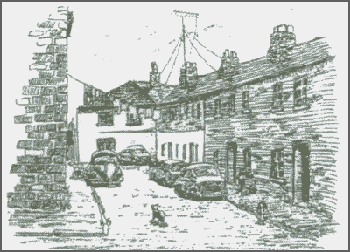Who Remembers Turner's Cottages?

This picture appeared in the book "Images of Ireland"
written by "Derek Stanley".
Click
here
to link to the Upper Leeson Street Area Residents Association website
which has an interesting article about Herbert Park.
This article appeared in the book "The Roads to Sandymount, Irishtown
and Ringsend" written by "Philip Doherty". It would have made my mother
laugh to have known the history of the home she was born in.
In its day many famous projects were carried out in Ballsbridge.
The framework for the Palm House of Belfast's Botanic Gardens was cast
here. Others include the ironwork for Westland Row Station and the Broadstone
Station. The conservatories at the Vice-Regal Lodge and Glasnevin Botanic
Gardens were also cast here. Perhaps Turner’s most famous work was carried
out at the Palm House at Kew Gardens in England. By the age of sixty
the works were taken over by his son William.
Around 1876 the works moved to a new site at North King Street. William,
however, continued to reside at Hammersmith House until his death is
1888. The house was renamed Melrose and became part of the Veterinary
College, where it served as the Principal's Residence. It was demolished
is the mid-1950's to make way for an extension to the college.
Turners Cottages were demolished in the early-1970's. Later, as I
stood for petrol in the Volkswagen garage across the road, I looked
over at the new building on the site and admired it. "That's a fine
new building." I said to the old petrol attendant. "And what's good
about it” he replied, "Sure what was wrong with the fine houses they
pulled down to build it? They scattered a whole community. They don't
give a damn about people nowadays!” I smiled and wondered it he was
the same man. You just can't win them all!
It was a fine sunny day in the summer of 1970, as I rambled up along
Shelbourne Road with a sketchbook under my arm.I turned right into Turner's
Cottages and, facing down ‘The Gut’, I began to draw what I considered
to be a vanishing part of Dublin life. Children played on the road in
the warm sunshine beneath the usual buntings of clothes drying on a
line, which stretched from one side to the other. Babies in prams and
go-cars were wheeled up to observe my progress by brothers or sisters
not much bigger than themselves. An old man rambled up and, looking
over my shoulder, asked why I was drawing the cottages. When I explained
my reasons he sharply replied, "They should pull the shagga lot down;
a bloody kip that's all it is." I was surprised by his sharp outburst
to say the least.
Why Turner's Cottages? Where did the name come? Well, Richard Turner
(1798- 1881) of No. 4 St. Stephen's Green, was an ironmonger. Around
1834 he moved to a house at Ballsbridge which had been built earlier
by a Doctor George Davy, for the sum of £1,400. The elector's fortunes
waned, however, and be was forced to sell the property. Turner moved
in and set up his works on the site, calling his house Hammersmith.
The works were a grand affair, with fine arched entrance gate, surmounted
by the Royal coat of arms featuring the lion and sphinx in cast iron.
Below this the name Turner appeared. To one side stood Hammersmith House
itself which featured cast iron verandas. To accomodate his workers
Turner built some houses, which is how Turner's Cottages originated.

